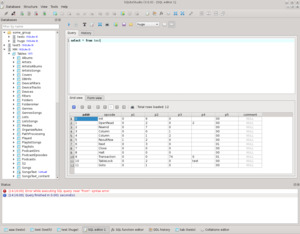
- SQLITE DATABASE READER INSTALL
- SQLITE DATABASE READER UPDATE
- SQLITE DATABASE READER WINDOWS 10
- SQLITE DATABASE READER SOFTWARE
- SQLITE DATABASE READER SERIES
It's useful to combine this with the IF NOT EXISTS statement, which prevents SQLite from clobbering an existing table. You can create a table with the CREATE query. Currently, your database is empty, devoid of any tables. SQL reads a lot like an ordinary English sentence, if a little robotic. The Structured Query Language (SQL) is named after what it provides: A method to inquire about the contents of a database in a predictable and consistent syntax to receive useful results. The intersection of a row and a column is called a field.
SQLITE DATABASE READER SERIES
There's a series of rows (called records in a database) and columns. Creating a tableĭatabases contain tables, which can be visualized as a spreadsheet. You now have an empty file on your hard drive, ready to be used as an SQLite database. If you have no database yet, you can create one at the SQLite prompt: sqlite >. When launching SQLite, you can either open a prompt in memory, or you can select a database to open: $ sqlite3 mydatabase.db However, data types and functions differ, so pay close attention to minor differences if you're familiar with another database. Databases take queries in Structured Query Language (SQL), and many SQLite queries are the same as what you may already know from the MySQL and MariaDB databases. These are administrative commands for your SQLite shell and are not database queries. Some of these commands are binary, while others require unique arguments (like filenames, paths, etc.). cd DIRECTORY CHANGE the working directory TO DIRECTORY binary ON |off Turn BINARY output ON OR off. bail ON |off Stop after hitting an error. backup ?DB? FILE Backup DB ( DEFAULT "main" ) TO FILE
SQLITE DATABASE READER UPDATE
This command provides an interactive shell so you can view and update your databases. You can interact with SQLite using the sqlite3 command.


This article introduces you to SQLite and the sqlite3 command so you can get familiar with the basics of how this database handles data. However, before using these libraries, it helps to understand what's actually happening with the database engine and why your choice of a database is significant. For this reason, there are SQLite interfaces (or "bindings") for Java, Python, Lua, PHP, Ruby, C++, and many many others. It's common to interact with a database through a programming language.
SQLITE DATABASE READER INSTALL
On macOS or Windows, you can download and install SQLite tools from.
SQLITE DATABASE READER SOFTWARE
If you don't have SQLite installed on Linux or BSD, you can install it from your software repository or ports tree, or download and install it from source code or as a compiled binary. The command provided by the tools is sqlite3 (not just sqlite).

On Linux, you probably already have these tools installed. You probably already have SQLite libraries on your system, but you need its command-line tools installed to use it directly. In summary, it's a reliable and simple system to use for storing and organizing data.

Free online course: RHEL technical overview.
SQLITE DATABASE READER WINDOWS 10
That's counting multiple databases on every Android and iOS device, every macOS and Windows 10 computer, most Linux systems, within every Webkit-based web browser, modern TV sets, automotive multimedia systems, and countless other software applications. SQLite is immensely common, with an estimated 1 trillion SQLite databases in active use. Should you require a license, you can purchase a Warranty of Title. SQLite has been dedicated to the public domain, which technically means it is not copyrighted and therefore requires no license. SQLite is a self-contained, lightweight database that makes it easy to create, parse, query, modify, and transport data. You can dump text to configuration formats such as INI, YAML, XML, or JSON, you can write out raw binary data, or you can store data in a structured database. There are many ways to store data for repeated use. Whether your users create simple text documents, complex graphic layouts, game progress, or an intricate list of customers and order numbers, software usually implies that data is being generated.


 0 kommentar(er)
0 kommentar(er)
